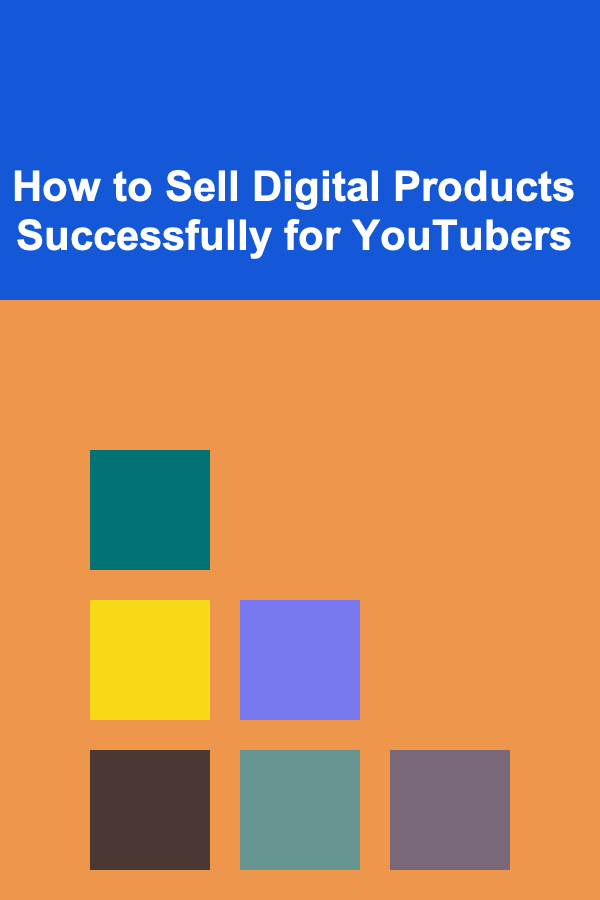
How to Sell Digital Products Successfully for YouTubers
ebook include PDF & Audio bundle (Micro Guide)
$12.99$6.99
Limited Time Offer! Order within the next:

In the ever-evolving world of content creation, YouTubers have moved beyond ad revenue and sponsorships to explore new and exciting opportunities for monetization. One of the most effective and profitable ways for YouTubers to diversify their income streams is by selling digital products. Whether it's e-books, courses, presets, or custom-designed merchandise, YouTubers can leverage their audience to build a sustainable and profitable business. However, selling digital products isn't as simple as putting something online and hoping for sales---it requires a strategic approach.
This actionable guide will provide YouTubers with an in-depth look at how to sell digital products successfully, from identifying the right products to market, setting up effective sales channels, and marketing to your audience.
Identifying the Right Digital Products for Your Audience
Before diving into the world of digital product sales, it's important to figure out what your audience wants and what aligns with your brand. The first step is to understand your audience's interests, challenges, and needs. Here are some common digital products YouTubers can sell:
1.1. Online Courses and Tutorials
As a YouTuber, you likely already create tutorials or educational content. You can expand on this by offering in-depth, paid courses or training materials that your audience can purchase for a more structured learning experience. These can range from video courses to written content, guides, and interactive lessons.
- Example: A tech YouTuber who teaches software development might sell a full course on creating apps, coding tutorials, or mastering a specific programming language.
1.2. E-books and Guides
E-books are one of the easiest digital products to create and sell. If you have expertise in a particular area, whether it's about gaming, fitness, cooking, or content creation, you can package your knowledge into an e-book. Guides that offer actionable tips and insights are also highly valuable to your audience.
- Example: A beauty YouTuber could create an e-book with makeup tutorials, skincare routines, or tips on building a beauty brand.
1.3. Digital Art and Templates
If you're an artist or graphic designer, you can sell digital assets like art, illustrations, and design templates. These products can include things like logo designs, social media templates, YouTube channel art, or even custom-created fonts. Many creators and small businesses purchase these items for their own use.
- Example: A lifestyle YouTuber who has a unique brand style could sell custom-designed templates for YouTube thumbnails, Instagram posts, and story templates.
1.4. Music, Sound Effects, and Audio Files
If you're a musician or have audio editing skills, you can sell royalty-free music tracks, sound effects, or loops. Many YouTubers and content creators need background music for their videos, and high-quality, copyright-free audio files are always in demand.
- Example: A gaming YouTuber might sell exclusive soundtracks or background music for streamers and fellow content creators to use in their videos.
1.5. Software, Tools, and Plugins
If you have coding skills or access to tools that improve the YouTube or content creation process, consider building and selling them. This could be video editing presets, custom plugins, or productivity tools that help other creators streamline their processes.
- Example: A YouTuber who specializes in video production might sell custom video editing presets for programs like Adobe Premiere or Final Cut Pro.
1.6. Merchandise and Custom Products
While physical products require more logistical effort, many YouTubers sell custom merchandise like T-shirts, hoodies, and mugs. However, with digital products, you can create unique virtual merchandise, like custom emojis, stickers, or digital goods for use in digital spaces.
- Example: A YouTuber might sell exclusive digital wallpapers, stickers for Discord, or virtual goods for popular games.
Setting Up Sales Channels
Once you've identified what digital product you want to sell, it's time to choose where and how to sell it. The right platform can make a significant difference in your sales. You have several options, depending on your needs and budget.
2.1. Selling Through Your Website
Having your own website allows for full control over the customer experience, branding, and pricing. You can use platforms like WordPress, Shopify, or Wix to set up a store that integrates with payment processors like PayPal, Stripe, and others. This also gives you the freedom to create a personalized shopping experience.
- Pros: Full control over pricing, branding, and customer engagement. You also own your audience data and can market directly to your customers.
- Cons: You need to drive traffic to your site, which can take time and require consistent marketing.
2.2. Use Third-Party Marketplaces
Selling on established marketplaces like Gumroad, Etsy, or Teachable can make the selling process easier. These platforms handle payment processing, delivery, and security, allowing you to focus on creating products.
- Pros: Built-in audiences and less hassle with payment and distribution.
- Cons: These platforms take a percentage of your sales, and you have less control over the customer experience and branding.
2.3. YouTube's Built-in Features
YouTube itself offers a number of monetization options that can be leveraged to sell digital products. For example:
- YouTube Merchandise Shelf: If you have more than 10,000 subscribers, you can use YouTube's built-in merchandise shelf to sell products directly from your channel.
- Super Chats and Memberships: You can also use Super Chats during live streams or create a YouTube Membership program that offers digital products (exclusive content, custom emojis, etc.) to members.
- Pros: Direct access to your audience without leaving the platform.
- Cons: Limited product offerings and revenue potential compared to an independent store.
2.4. Selling via Email Marketing
Email marketing allows you to directly reach your subscribers and promote your digital products. You can build an email list by offering free content or special deals and then send promotional emails to your audience when you launch new products or offer discounts.
- Pros: High ROI, allows for personalized communication, and can drive repeat sales.
- Cons: Requires building and maintaining an email list, which takes time and effort.
Pricing Your Digital Products
Pricing is a key element in your product's success. Price your product too high, and you risk alienating potential buyers. Price it too low, and you may not be able to generate enough revenue. Here are some factors to consider when pricing your products:
3.1. Know Your Audience's Willingness to Pay
Consider the demographics of your audience and their typical spending habits. For example, if your audience is younger and more price-conscious, you might opt for a lower price point or offer a tiered pricing structure (basic vs. premium). On the other hand, if your audience is more professional or industry-focused, they may be willing to pay more for high-quality, in-depth products.
3.2. Competitive Research
Research what similar creators or businesses are charging for comparable digital products. This will give you a good idea of what the market can bear. However, make sure your pricing reflects the unique value your product offers.
3.3. Offer Discounts and Bundles
You can also experiment with offering limited-time discounts, bundle deals (e.g., "Buy 2 courses, get 1 free"), or exclusive offers to your subscribers to encourage purchases.
3.4. Consider Recurring Revenue
If you're offering a service or product that benefits from continuous updates or access (like a membership site, subscription service, or SaaS product), pricing it on a recurring model (monthly or yearly) could provide a steady income stream.
Marketing and Promoting Your Digital Products
Effective marketing is crucial in driving sales of digital products. Fortunately, as a YouTuber, you already have a platform with an engaged audience that trusts you. Here's how to leverage that:
4.1. Promote in Your Videos
The most direct way to promote your digital products is within your content. Integrate subtle mentions or even dedicated segments into your videos showcasing your product. Use call-to-action (CTA) phrases like "If you want to learn more, check out my course in the description below!"
4.2. Build a Strong Social Media Presence
Extend your reach by promoting your products on other social media platforms. Engage with your audience on Twitter, Instagram, Facebook, and TikTok. Share sneak peeks of your products, behind-the-scenes content, and testimonials to build anticipation.
4.3. Create Lead Magnets
Offer free content that captures your audience's attention, like downloadable templates, free mini-courses, or guides. Once people download or engage with the free content, you can use email marketing to nurture them and eventually offer your paid products.
4.4. Collaborate with Other Creators
Collaborating with other creators in your niche is a great way to cross-promote digital products. You can team up for a webinar, create joint content, or simply shout each other out on social media.
4.5. Use Paid Ads
If you have the budget, consider using paid advertising on platforms like Facebook, Instagram, or Google to drive traffic to your digital product sales pages. Retargeting ads can be particularly effective, as you can target users who have already engaged with your YouTube channel.
Providing Exceptional Customer Support
Customer support plays a crucial role in maintaining trust and fostering long-term loyalty. Here's how to provide excellent service:
5.1. Respond Quickly
Ensure you respond to customer inquiries in a timely manner. Whether it's via email, social media, or your website's support system, prompt replies show that you value your customers.
5.2. Offer a Money-Back Guarantee
A money-back guarantee can help alleviate any concerns potential buyers might have. It shows that you stand behind your product and are confident it will provide value.
5.3. Keep Improving Based on Feedback
Regularly ask your customers for feedback and use it to improve your products. This creates a sense of community and makes your customers feel involved in the development of your brand.
Conclusion
Selling digital products can be an incredibly rewarding and profitable avenue for YouTubers. By creating valuable products, choosing the right platforms, and marketing effectively, you can successfully monetize your expertise and build a sustainable business. The key is to stay engaged with your audience, provide exceptional value, and remain consistent with your efforts. With the right strategy, YouTubers can turn their passion for content creation into a thriving digital product business.

Best Organization Tools for Students
Read More
Building High-Performing Teams: Strategies and Techniques for HR Managers
Read More
How to Create a Checklist for Essential Paperwork
Read More
How to Design a One-Page Website That Converts Visitors Into Clients
Read More
How to Stage Your Rental Property for Showings
Read More
How to Use Soundproof Sealant from Home Depot Effectively
Read MoreOther Products

Best Organization Tools for Students
Read More
Building High-Performing Teams: Strategies and Techniques for HR Managers
Read More
How to Create a Checklist for Essential Paperwork
Read More
How to Design a One-Page Website That Converts Visitors Into Clients
Read More
How to Stage Your Rental Property for Showings
Read More